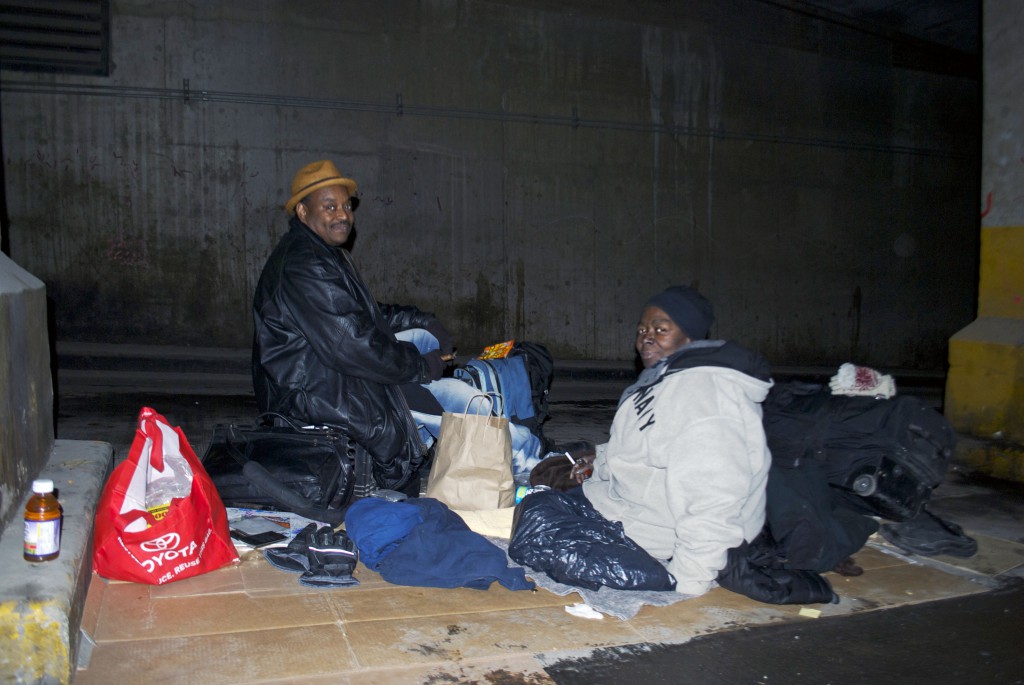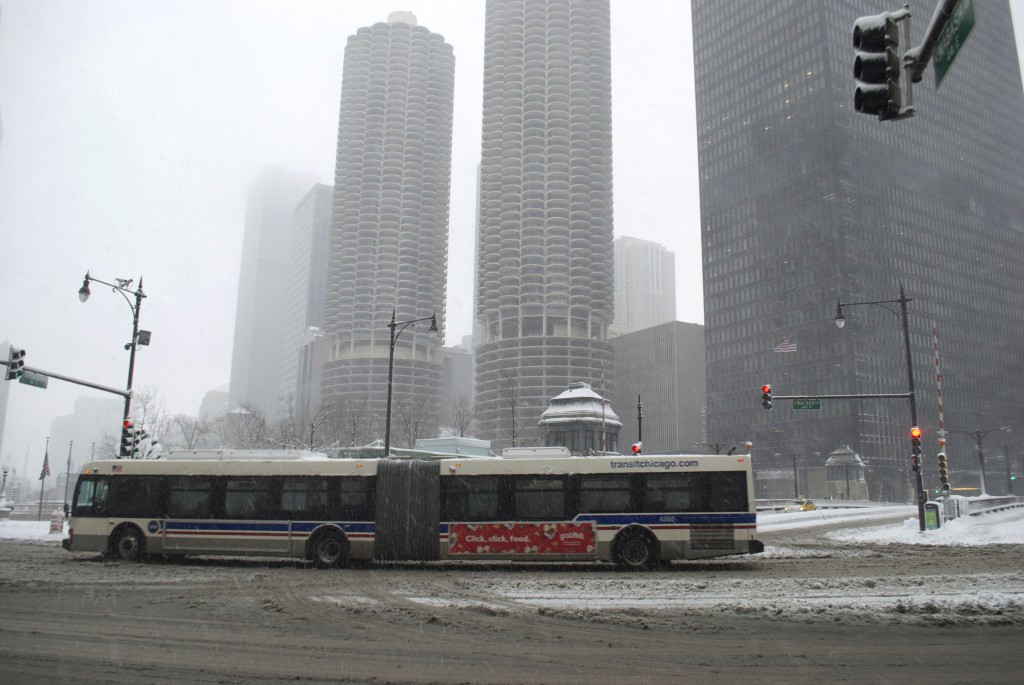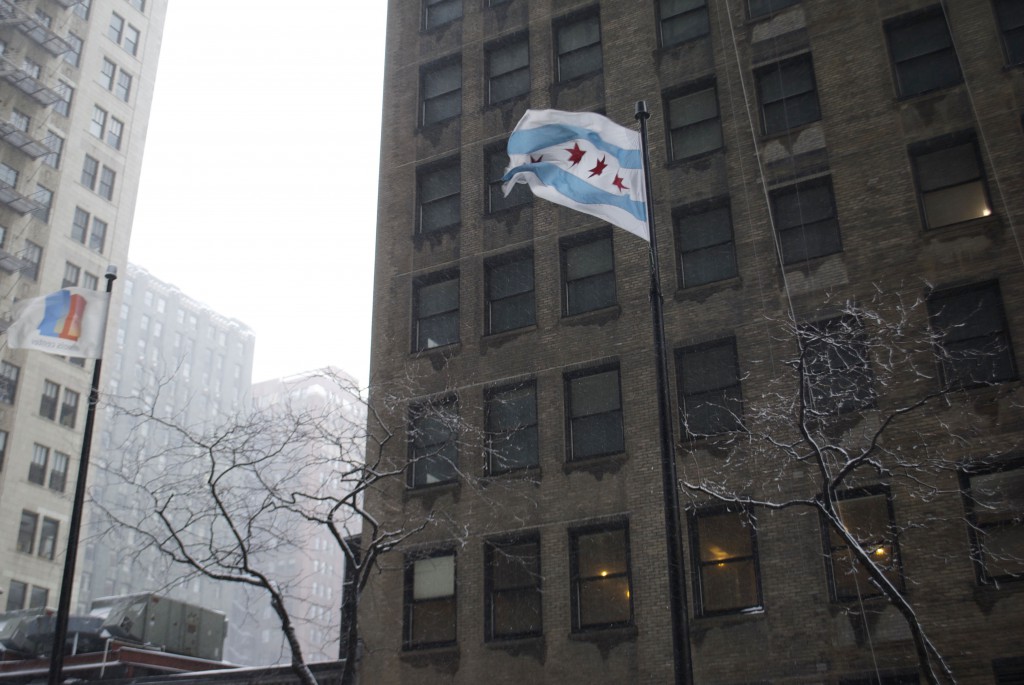By Adrienne Hurst
Geronimo Lightfoot has a home. It’s between two concrete pillars underneath the Illinois Center on Michigan Avenue; a cozy nest of blankets, paper bags and empty cans of Natural Light.
The 54-year-old endures Chicago’s biting winters in the wind-sheltered underpass of Lower Michigan Avenue. Though this one’s coming to an end, he’s kept warm using the few amenities his monthly disability check affords him—a result of kidney failure that happened two years ago—and the occasional hand warmers donated by volunteers and passersby.
And another thing: love.
“Yeah, I came out here for my boyfriend,” Joyce Wiggins, 62, said with a grin.
Wiggins and Lightfoot met 10 months ago at Four Winds Casino in Michigan, where Lightfoot was spending an evening away from the elements and Wiggins was enjoying a night of gambling. She didn’t live on the streets at the time, but she “wasn’t doing much” back home in Ann Arbor, either. “I was living with my cousin, babysitting and house-sitting,” she said. “I followed [Lightfoot] here.”
The couple is in good company beneath Chicago’s bustling shopping district. Their echoing underpass is sprinkled with tents and piles of blankets sheltering dozens of the city’s homeless. It’s warmer here than on the streets above, where winds faster than the speed limit can make wool coats feel almost futile. It’s an area volunteers and employees at the Chicago Department of Family and Support Services (DFSS) know to scrutinize during their biennial point-in-time (PIT) count of the city’s homeless population.

Lightfoot and Wiggins weren’t around for this year’s count. They were resting on the Red Line, sleepily following its path from Howard to 95th Street and back again. “The train’s got heat, so that’s better than being out here,” Lightfoot told me, rubbing a leather-gloved hand on his knee. “You just gotta stay alert for pickpockets.”
On just one night in winter 2014, city employees and volunteers counted 6,294 homeless individuals while scouring the streets and city-funded homeless shelters. Nearly one thousand were sleeping outdoors that night in around zero degree weather.
A five-month-long winter
The Cook County Medical Examiner’s Office measures the beginning and end of winter by a grim criterion: hypothermia body count. It’s a season flanked by the first and last cold-related deaths. This winter began on Nov. 20 when 52-year-old David Powells, a homeless man, was found unconscious on Chicago Avenue. The combination of acute alcohol poisoning, hypertensive cardiovascular disease and cold exposure proved fatal.
By the medical examiner’s standards, last winter didn’t end until April 3, 2014.
“The interesting thing is that we usually see most of our hypothermic patients in the emergency room during October, and then during April, May,”said Dr. Jeffrey Schaider, chairman of the Department of Emergency Medicine at the Cook County Health and Hospital System. “You wouldn’t expect it, but think about it: It’s early May, late April, fairly warm out. You lie down on a park bench, dressed in a t-shirt. You have too much to drink and you fall asleep. It starts to drizzle; it gets down to the 40s. Your body temperature will drop pretty quickly in that situation.”
I wondered why many displaced people continue to sleep on Chicago’s trains and underpasses even with shelters available. On Thursday, Jan. 22, a week before I met Lightfoot, I followed DFSS employees for this year’s federally mandated PIT count.
Tallying the displaced
Chicago is one of 414 U.S. Continuums of Care (CoC)—regional or local planning bodies in charge of directing homeless services—that conduct a biennial PIT count. According to an August 2014 analysis by the Chicago Coalition for the Homeless, the number of Chicagoans without permanent housing could be as high as 138,575 when those living temporarily with family or friends are included.
From 8 p.m. to 2 a.m. that Thursday, I watched as John Pfeiffer, DFSS First Deputy Commissioner, knelt with a pen and clipboard before men and women wrapped in layers of blankets. He asked if they would be willing to answer a few survey questions: how long they had been homeless, whether they dealt with substance abuse or mental illness, and other questions. The questions are intended to capture a “snapshot” of Chicago’s homeless population, which will ultimately help direct federal funding when the data is released this summer.
Many were asleep in tattered tents along the fringes of Lower Wacker and Lower Columbus Drive. DFSS employees tapped at the tarps of their residences in an attempt to wake them up, many times apologizing and explaining the purpose of their visit. Some of those residents became audibly upset; others were either too intoxicated or delirious to provide coherent answers. Irritated by the crowd of reporters and city employees, one man agreed to speak only if someone purchased a copy of “StreetWise” from him.
Disturbing some of Chicago’s most vulnerable residents to ask about their lives felt tense. Despite their good intentions, DFSS workers were dismissed by some who were trying to sleep or otherwise maintain privacy.
I went back to Lower Wacker and the people sleeping on Chicago’s wintry streets one morning in February, when they would be awake and more willing to talk. That’s where I met Lightfoot and Wiggins.

‘I had nowhere to go’
Lightfoot hasn’t set foot in a shelter since last winter, he told me. He spent most of his time outdoors before becoming homeless, working in construction and eventually quitting to become a live-in caretaker for his father who had Alzheimer’s disease. When his father passed away two years ago, “I had nowhere to go, so I ended up in shelters,” Lightfoot said. But incidents of theft and bed bugs eventually led him back to the streets.
Lightfoot is faring better this season than he did last year. Winter 2013-2014 was Chicago’s coldest on record, and during one of its bitterest days, Lightfoot passed out on State Street.
He asked a postman to call 9-1-1 as soon as he came to. Lightfoot knew that progressive loss of consciousness can signal severe hypothermia, a condition that contributed to the deaths of 32 people in Cook County last winter. About one-third of them were homeless, according to the medical examiner’s office.
“We see them all the time in the emergency room,” Schaider said.
The Chicago city government funds 10 emergency shelters with a total of 581 beds—places to sleep for 12 hours or less—and 41 interim shelters with 2,708 beds, places to stay for longer periods and receive housing services. That number doesn’t include independently funded shelters like the Pacific Garden Mission, Chicago’s largest and longest-running shelter, where more than 1,100 homeless men, women and children sleep during the winter.
Despite the shelters that are in place, last year’s PIT count found 16 percent of homeless Chicagoans living on the street. DFSS employees and volunteers provided those individuals with directions to the nearest shelter as part of the count process.
But “even during the polar vortex, we had people who did not want to come in,” said DFSS spokesman Matt Smith during this year’s count. “They might have taken blankets, they might have taken coffee, but they refused” to visit a shelter.
Pfeiffer listed a general distrust in institutional care as a possible factor. “Mental health is probably the biggest issue,” he said. “Or perhaps they’ve been abused in a shelter before. They might have had a bad experience.”
Lightfoot put it this way: theft is unbearable when all you own is on your back. He said he experienced that on more than one occasion at the shelters. “When you have that bad taste, you don’t want to go back,” he said.
“And I can’t deal with bed bugs,” Wiggins added, shaking her head in disgust. Living with Lightfoot, she’s never stayed in a shelter. “I can’t deal with bugs of any kind.”

Winter isn’t over—but this year’s ‘a cakewalk’
Although Lightfoot applied for low-income housing in December, his application fell through due to high demand, he said. He’ll try again soon. But until then, he and Wiggins have a routine in place for the colder days: They spend their mornings in the Harold Washington Library, afternoons in the Barnes and Noble on Jackson Boulevard, and nights on the red line.
“Last year, it was rough,” Lightfoot said. “I seen guys who totally lost their toes. But this year?”
He paused to gesture at the concrete substructure of Michigan Avenue above him, beyond which a February sky was beginning to blanket the city in more than a foot of snow. It was the first blizzard of the season and the fifth heaviest snowfall in city history. Directly above us, the city flag by the Illinois Center writhed in nearly 40 mph winds.
”This is a cakewalk,” Lightfoot said, cradling an unopened packet of Hot Hands in his lap. He threw his head back and laughed. Wiggins laughed, too.


